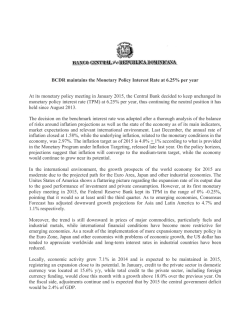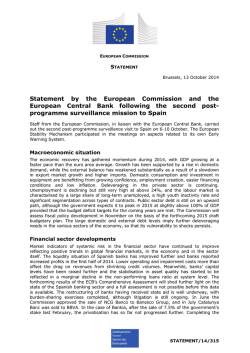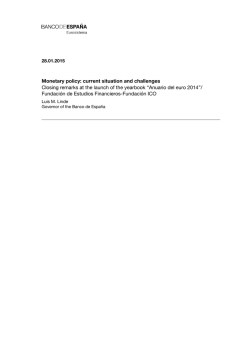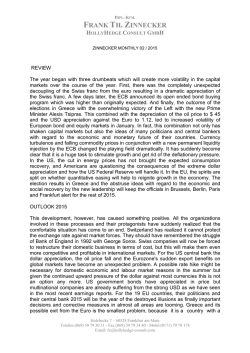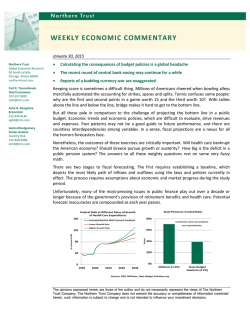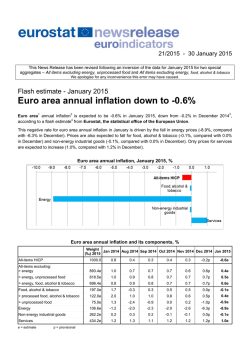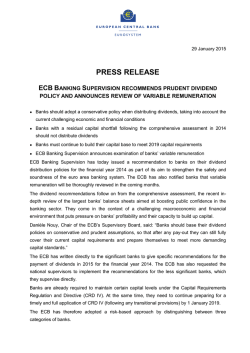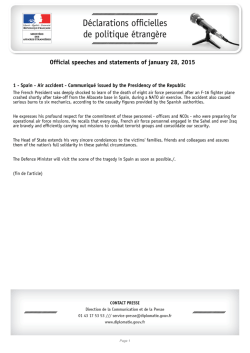
Governor. IIF Spring Meeting (91 KB )
25.05.2016 Macro vulnerabilities, regulatory reforms and financial stability issues IIF Spring Meeting Luis M. Linde Governor I would like to thank Tim Adams, President and Chief Executive Officer of the International Institute of Finance, for his kind invitation to participate in your Annual Spring meeting. In my speech I will try to cover three topics: macro developments and challenges both in the international context and in the euro area; the stance of monetary policy in different areas; and regulatory changes. The International Context Today, the recovery of the world economy remains disappointingly uneven and weak. Global GDP growth in 2015 was 3.1 %, the lowest figure since 2009, and projections by most of the international institutions have been revised downwards again. In spite of that, financial markets have experienced a favourable trend in recent months. The more accommodative tone of monetary policy in most of the world, some macroeconomic data that, although not too buoyant, moved away expectations of a new recession and, in a number of cases, corporate profits, better than expected, helped reverse the worrying trends that markets showed at the beginning of the year. However, serious risks remain. Many developed economies have recovered the level of activity prior to the crisis, but their growth rates have been low by historical standards. Something similar happens with inflation, which in most cases remains below the central banks’ targets. In the United States, recent indicators suggest a moderate rebound of activity in the second quarter, although for the year as a whole analyst´s projections point to a growth rate below 2 %. Underlying inflation is below the Fed's target but it shows slight upward trend. These new data, jointly with the improvement in financial and external conditions, the publication of Federal Open Market Committee (FOMC) minutes and statements of some of its member have changed market expectations. An increase in the Federal Funds rate during this year is now fully priced in and markets allocate a probability of 20 % to a second increase. Because of its systemic importance, China is indeed attracting a great deal of attention. The management of the structural reforms pointing to change its model of development is complex. A key element of this process is the reform of the financial sector. As for the situation in Latin America, although there is considerable heterogeneity by countries, these economies have been experiencing a slowdown in recent years due to their high dependence on the exports of raw materials, their trade integration with China and their financial integration with the US. In addition, there are also internal factors, such as the modest productivity growth. But the recent improvement in financial markets has especially benefited countries in that region, as their sovereign risk premiums have diminished, their exchange rates are now appreciating and capital inflows have returned. This could provide scope for macroeconomic policies to support growth by implementing structural reforms. All in all, the current situation of the world economy is characterized by a high degree of uncertainty. Downward risks are more evident in emerging economies insofar markets 3/7 maintain doubts about the strength of the Chinese economy, the behaviour of commodity prices and the course of monetary policy in the US. Euro area: recent developments and challenges ahead In the euro area, the prolonged period of subdued economic activity has taken its toll on the welfare of our societies as well as on confidence and the capabilities to recover soon a higher growth rate. Some rough numbers may help to illustrate the dimension of the challenges ahead. According to the Spring-2016 Economic Forecast by the European Commission (EC), the level of employment will reach that recorded in 2008 only by next year, and a similar comparison could be made in terms of the real GDP per capita. Long-term forecasts have been revised downwards in recent years –being potential growth now most likely closer to 1 % rather than to 2 %-, on account not only of demographic factors, but also the legacies of the crisis. Macroeconomic developments started to turn more positive in the second half of 2013 and in 2014, and accelerated in 2015, although only up to a modest rate of 1.5 %, supported by an expansionary monetary policy, reforms of the institutional framework of the EMU, reduced financial stress, and, more recently, lower oil prices. The first weeks of 2016 came with a significant deterioration of global financial indicators, like stock market valuations or debt spreads. In the case of the euro area, aggregate financial conditions fell back to their prevailing levels of one year before, just when the ECB had announced an expansion of its already very ambitious QE program. Preliminary GDP data for first quarter 2016 Q1 posted a higher number (+0.5 % compared with +0,3 % in the last two quarters of 2015). Uncertainty and a weak global economy keep the balance of risks to the downside, posing important challenges for policy makers that require the contribution of all areas of economic policy at both the national and the euro levels. Challenges and the way forward in the euro area In the current circumstances, synergies among economic policies should be better exploited with a view to maximizing the stimulus to aggregate demand and to accelerate the recovery. There has been progress on structural reforms in recent years, particularly in those countries most affected by the crisis. On the fiscal front, the consolidation process has paused somewhat and, according to the Spring-2016 European Commission’s forecasts “fiscal policy is expected to be slightly supportive to growth this year”. There are also important political challenges ahead. The management of the flow of refugees, the referendum that the United Kingdom will hold next month on its EU 7 4/7 membership, and, more recently, the negotiations with the United States to sign the Transatlantic Trade and Investment Partnership (TTIP) are leading sometimes to heated debates on the institutional framework of the EU. In connection with these, and other, challenges, I would like to recall the roadmap drawn up in the Five Presidents’ Report published last year, which delineates steps for further economic integration within the euro area through both real convergence and some mutualization of risks. Making progress along the lines suggested in the Five President’s Report would not only improve the resilience of the euro area to future shocks, but would help building up the necessary confidence to create employment and lifting growth potential. Monetary policy I would like now to make a few comments on the main features of our monetary policy scenario. Since the beginning of the crisis weak domestic demand in the euro area has pushed down core inflation well below the medium-term objective. The subsequent fall in oil prices has aggravated this situation and core prices have grown in the last years at very moderate rates, around 1 % or less. The extent and scale of the actions taken in the euro area since the spring of 2014 to address the risks of too low inflation have been unprecedented, covering four strategic lines: negative remuneration in the deposit facility; communication policy and the use of forward guidance; several programs aimed at restoring the bank lending channel of monetary transmission; and the program of quantitative easing that entails large scale purchases of private and public assets. Since October 2014, the size of the Eurosystem’s balance sheet has increased by 50 % up to €3tn with the implementation of the Extended Asset Purchase Program, whereas the deposit facility rate, which is a key money market reference in the current context of excess liquidity, has remained in negative territory, reaching its lowest record at -0.40 % in March. The ECB has not been alone in the use of unconventional monetary tools once interest rates reached its effective floor. The Federal Reserve engaged in successive rounds of quantitative easing through asset purchase programs. All in all, the balance sheet of the Federal Reserve increased from 870 billion in September 2008 to more than 4.4 trillion, holding now more than 30 percent of the stock of outstanding Mortgage Backed Securities and nearly 25 % of outstanding Treasuries. The Bank of England also embarked in quantitative easing through purchases of public sector assets, and holds now almost 25 % of the total outstanding UK public debt. 5/7 The Bank of Japan is implementing an intensive quantitative easing program and, similarly to the ECB, they include both public and private issues, but with a very important weight of public debt, which amounts now to more than 80 % of Bank of Japan’s total assets. The size of the Bank of Japan balance sheet represents now more than 75 % of the Japanese GDP. The provision of ample liquidity by Central Banks has contributed to restore financial market functioning in situations of severe stress and so, to support the economy. In the euro area, the effects of ECB actions are estimated to have contributed to reduce financial stress and fragmentation, easing financing conditions and helping to restore the credit channel. According to available estimates, all these developments have added significantly to inflation and GDP growth over the last two years. And, although quantitative estimates are surrounded by some uncertainty, it is clear by now that this battery of monetary policy actions have reduced the likelihood of very adverse scenarios. In due course, a need to restore more normal monetary conditions will arise, although its precise timing is impossible to predict and will depend on the cyclical situation of each economy or monetary area. This normalization process may create a scenario of monetary policy divergences, in which there maybe unexpected exchange rate movements and communication is very relevant. The combination of macro challenges and regulatory reforms: The current and forthcoming financial landscape for banks I will comment now on the financial landscape for banks and the regulatory reforms. The prevailing low-interest rate environment may pressure banks’ interest rate margins downwards when the negative impact on the interest rate differential exceeds the positive effect of low interest rates on banks’ activity. This potential unintended consequence of monetary policy lies in parallel with other factors that are putting pressure on banks’ profitability, in particular, regulatory reforms aimed at addressing vulnerabilities in the global banking system as well as deficiencies in the current framework. Some of these reforms have already been implemented and banks have improved their resilience. Solvency ratios have been reinforced with a new calibration of the requirements and the definition of the eligible capital instruments for the numerator of these ratios. However, different problems in the denominator related to the measurement of risk still persist and should also be addressed. In this regard, I would say that the major general outstanding issue to finalize the Basel post-crisis reforms is how to mitigate the unwarranted variability in the risk weighted assets that are calculated by banks when using internal models. This revision should be feasible by striking a right balance between sensitivity, simplicity and comparability. 7 6/7 There is a special focus also on avoiding significant increases for overall capital requirements. This means that, given that we have already reinforced the level and quality of capital for the overall banking industry, the impact on requirements of the current revision should be borne by those parts of the banking system where the major unwarranted low asset densities are located. This objective of reducing the unwarranted variability in risk-weighted assets could be achieved through the implementation of a combined set of measures that ensure risksensitivity and comparability. Internal models are being revised with that objective in mind. First, there are some portfolios which should be defined as non-modelable, due to the scarcity of reliable data (i.e. low default portfolios). Second, among those exposures or risks that are considered as modelable, there are reasons that justify the revision being undertaken on definitions and methodologies. And, third, consideration should be given to the inclusion of restrictions to model parameters as a means to facilitate the supervisory task, so avoiding abnormally low values for individual parameters. In order to limit unwarranted variability in risk-weighted assets, a common backstop that has enough granularity to ensure risk-sensitivity is also needed. In this regard, capital floors based on the standardized approaches and designed as a limit to the output of internal models may be considered. In this regard, the revision of standardized approaches is also relevant. This revision seeks to incorporate the lessons learned in order to increase their risk sensitivity avoiding undue complexity. And last, but not least, the leverage ratio could also play an additional role in mitigating bank’s and supervisor’s model risk and measurement error, providing a backstop to riskbased capital measures. Indeed, it could also play a role by itself by constraining leverage in the banking system. But a really crucial challenge is good calibration. Furthermore, there are difficult questions to be addressed regarding impact assessments: What is the meaning of “significant” when referring to the increase of the capital requirements? What is the best approach to capture outlier banks which are making savings through the use of aggressive modelling techniques? Is the impact going to be measured by categories of banks with similar profiles and business models? In this sense, in order to ensure that the analysis is based on the best quality data, the engagement of the industry is crucial, both through sharing its views by responding to consultation processes, and also by contributing with the best quality data to the quantitative impact study being conducted by the Basel Committee. To conclude, it is essential that the final design of the whole framework is consistent and that any potential interactions between different measures are properly evaluated. To conclude, I will say that it will be possible to design a framework that keeps the incentives for sound risk management and that eliminates unwarranted differences in risk weighted assets among banks, while avoiding any significant increase in the capital requirements for the global banking system. Thank you very much for your attention. 7/7
© Copyright 2025
